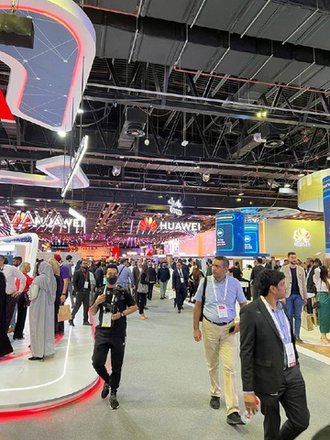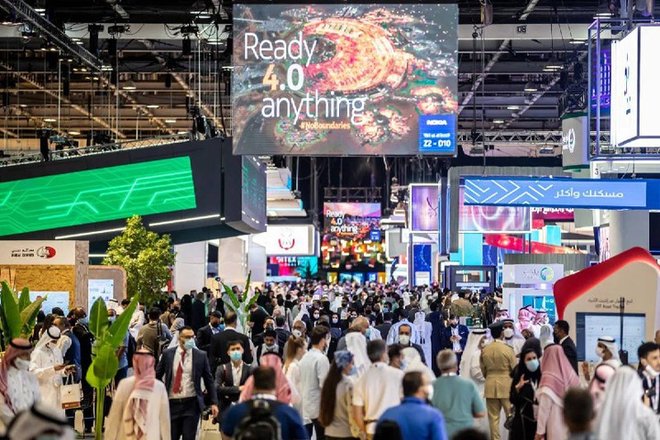The future starts from the East: the key trends of telecommunications at GITEX Global 2022 in Dubai
GITEX Global 2022 opened on October 10 is held at the Dubai World Trade Center with the participation of more than 5,000 exhibitors from 90 countries. RSCC’s delegation is taking part in the exhibition.
The GITEX GLOBAL show discusses the main technological trends, including those that involve the use of satellites: IoT, smart transportation, unmanned technology, 5G-enabled business operations, and next-generation IoT-focused cybersecurity.
The Middle East and North Africa (MENA region) is one of the most promising markets for satellite operators, as its countries are actively involved in the ‘connecting the unconnected’ program. All states of the region have committed to developing the communications infrastructure and promoting digital services among their citizens, businesses and government agencies. It is planned to use satellite channels to cover remote areas, which increases the role of operators.
These plans, in turn, coincide with the desire of regional operators — Arabsat, Es'hailSat and YahSat — to expand their zone of influence and effectively implement new capacities. In order to bring competitive offers to the market, operators are following another current trend and ordering high-capacity satellites with controlled digital payloads.
New vehicles — new strategies
The satellite operator Arabsat has signed a contract with SpaceX to launch the Arabsat 7A satellite, which is to replace and expand the services of the Arabsat 5A satellite, which is nearing the end of its service life.
Thales Alenia Space is building Arabsat 7A based on its Space Inspire platform; it will be a satellite with a software-defined payload. In addition to wide beams of Arabsat 7A, the new satellite will form a multi-beam Ku-band zone to provide high capacity for vertical markets in the Middle East, Africa and Europe. The launch of Arabsat 7A is scheduled for 2023.
Badr N. Alsuwaidan, Chief Technical Officer of Arabsat, said the order for a satellite with a software-defined payload was the first step in the operator’s new transformation strategy. It aims to ensure sustainable growth of the satellite communications business in the region and establish partnerships with governments and businesses in different countries to bridge the digital divide and connect the unconnected.
Flexible loading, according to Alsuvaidan, is one of the key factors that ensure the development of satellite communications, and will allow the operator to provide competitive offers.
He is confident that currently the need for telecommunications services is at its peak in MENA. The development of 5G networks is also creating demand for satellite services, and Arabsat plans to introduce a 5G backhaul service. This will help cellular operators to cover remote regions.
Growing finances is an indicator of market development
The state and prospects of the market can also be judged by the financial position of operators. Al Yah Satellite Communications Company PJSC (Yahsat), a public company, has announced an interim dividend of AED 196.6 million ($53.5 million) by October 14. On a year-on-year basis, the operator plans to pay a total dividend of at least AED 393.3 million, up 2% from the previous year.
Ali Al Hashemi, Chief Executive Officer of the Yahsat Group, said that the market and the operator's business model were generating a solid cash flow.
Yahsat owns a constellation of five space vehicles — Al Yah 1 (52.5°E), Al Yah 2 (47.5°E), Al Yah 3 (20°W), Thuraya 2 (44°E, inclined orbit), Thuraya 3 (98.5°E, inclined orbit). The operator is actively promoting satellite broadband service in MENA. The growth of dividends paid by the company serves as an indirect indication that the regional satellite communications market has ceased to stagnate and has begun to grow.
New market entry
Es'hailSat is another regional operator that plans to enter the international arena. Ali Ahmed Al Kuwari, President and CEO of Es'hailSat, says the operator is looking to expand beyond the local market and IBC provides this opportunity.
Thus, at the exhibition Es'hailSat managed to demonstrate the capabilities of Es'hail-1, Es'hail-2, as well as a wide range of services that would be provided through a new modern teleport in Doha.
Government activities
In the past few years, state institutions have begun to act along with commercial structures — many countries are developing their own space programs. The UAE authorities announced the creation of a fund in the amount of AED 3 billion ($820 million) to finance the development of satellites and support their space program.
The first project supported by the fund is the creation of a national system of radar satellites for all-weather Earth remote sensing. The system will be aimed at solving environmental problems and primarily monitor oil spills and other natural and man-made emergencies. It will also carry out surveillance of maritime vessels and provide information to maritime rescue services. In addition, remote sensing satellites should help the UAE contribute to dealing with climate change.

